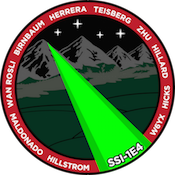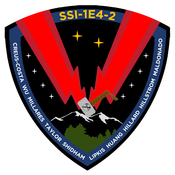Difference between revisions of "Optical Communications Team"
Smaldonado (talk | contribs) (Added to Optical Communications category) |
|||
| (14 intermediate revisions by 3 users not shown) | |||
| Line 1: | Line 1: | ||
| − | + | {{opcomms-sidebar}} | |
| + | [[File:SSI-1E4_Small (175x175).png|frame|left|Mission patch for the Satellites Team's first successful [[SSI-1E4|10km optical link]], which achieved an optical lock]] | ||
| + | [[File:SSI-1E4-2.png|thumb|175px|left|On a subsequent test, the team was able to bidirectionally encode and decode a string of bits.]] | ||
| − | [[Category:Optical Communications]] | + | Optical Communications was a student-led project that aimed to develop the capability to establish high-bandwidth data links over free space. The group began work at the beginning of the 2014-2015 academic year, under the leadership of Thomas Teisberg and Logan Herrera. It was initially formed to investigate the possibility of space-based optical communications, with the intent to participate in the NASA [[CubeQuest Challenge]], a competition for small satellite design, but later moved away from the competition design constraints. |
| + | |||
| + | The Optical Communications group evolved to focus on the establishment of long-distance optical links, with the eventual goal of integrating this technology into a CubeSat form-factor satellite for the purposes of space-based communication. In its first year of existence, the group developed a system involving mechanized altitude/azimuth mounts, an original receiver device consisting of a Fresnel lens and photodetector, and a MATLAB pointing algorithm based on reference point alignment. The group’s final test of the 2014-15 year resulted in the successful establishment of an optical lock over [[SSI-1E4|10 kilometers]]. The group was able to successfully transmit encoded data over 10 kilometers in August 2015. | ||
| + | |||
| + | <noinclude>[[Category:Optical Communications]]</noinclude> | ||
Latest revision as of 04:21, 2 September 2020

Optical Communications was a student-led project that aimed to develop the capability to establish high-bandwidth data links over free space. The group began work at the beginning of the 2014-2015 academic year, under the leadership of Thomas Teisberg and Logan Herrera. It was initially formed to investigate the possibility of space-based optical communications, with the intent to participate in the NASA CubeQuest Challenge, a competition for small satellite design, but later moved away from the competition design constraints.
The Optical Communications group evolved to focus on the establishment of long-distance optical links, with the eventual goal of integrating this technology into a CubeSat form-factor satellite for the purposes of space-based communication. In its first year of existence, the group developed a system involving mechanized altitude/azimuth mounts, an original receiver device consisting of a Fresnel lens and photodetector, and a MATLAB pointing algorithm based on reference point alignment. The group’s final test of the 2014-15 year resulted in the successful establishment of an optical lock over 10 kilometers. The group was able to successfully transmit encoded data over 10 kilometers in August 2015.
